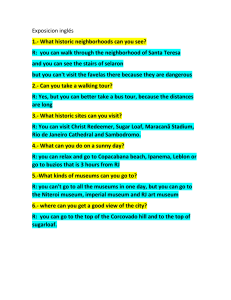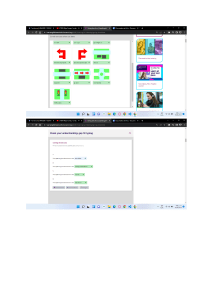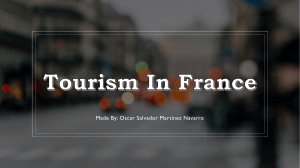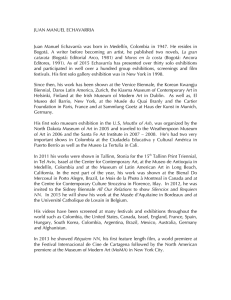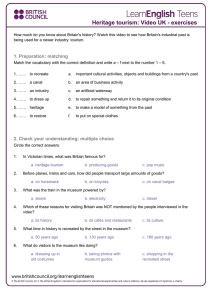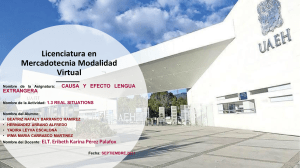Pausing Reflection and Action Decolonizing Museum Practices
Anuncio
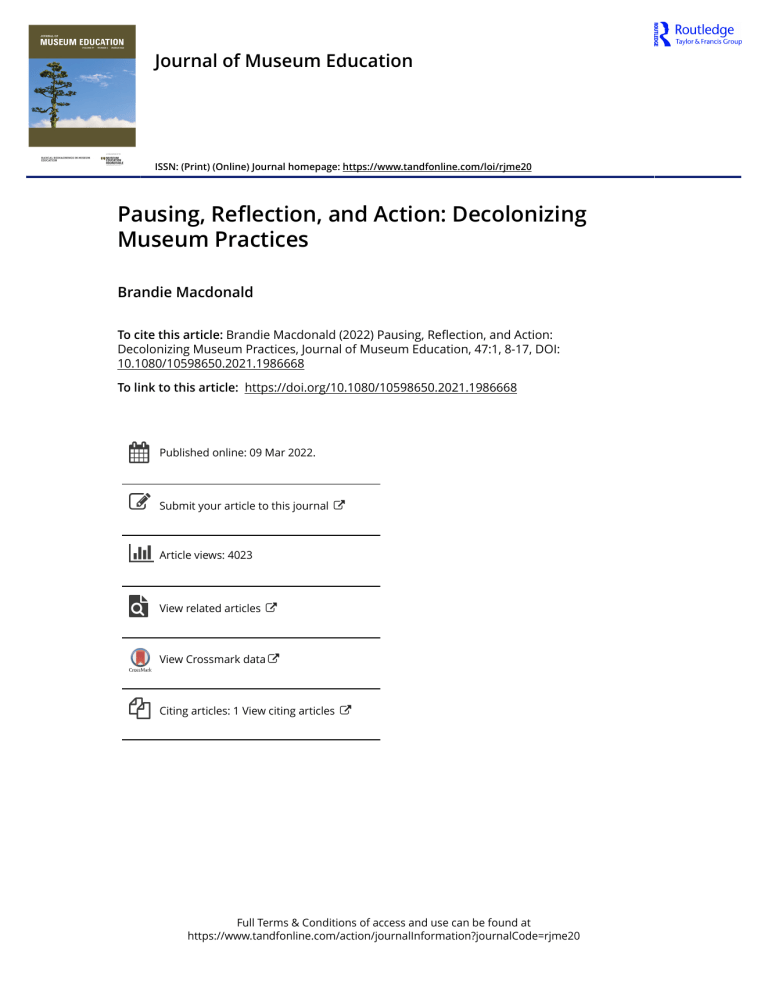
Journal of Museum Education ISSN: (Print) (Online) Journal homepage: https://www.tandfonline.com/loi/rjme20 Pausing, Reflection, and Action: Decolonizing Museum Practices Brandie Macdonald To cite this article: Brandie Macdonald (2022) Pausing, Reflection, and Action: Decolonizing Museum Practices, Journal of Museum Education, 47:1, 8-17, DOI: 10.1080/10598650.2021.1986668 To link to this article: https://doi.org/10.1080/10598650.2021.1986668 Published online: 09 Mar 2022. Submit your article to this journal Article views: 4023 View related articles View Crossmark data Citing articles: 1 View citing articles Full Terms & Conditions of access and use can be found at https://www.tandfonline.com/action/journalInformation?journalCode=rjme20 JOURNAL OF MUSEUM EDUCATION 2022, VOL. 47, NO. 1, 8–17 https://doi.org/10.1080/10598650.2021.1986668 Pausing, Reflection, and Action: Decolonizing Museum Practices Brandie Macdonald ABSTRACT ARTICLE HISTORY Museums are complex, intersectional informal learning spaces that are situated in a distinctive positionality of power, social trust, and colonialism. For many people, they serve as community spaces that empower the imagination and connect intergenerational learning, while simultaneously functioning as prestigious institutions for research and scholarship. Yet, for Black, Indigenous and Communities of Color, museums equate to pain. Museums are everlasting monuments that replicate colonial erasure and violence through their exhibitions, educational content, and through their curatorial, stewardship, and collecting practices. In thinking about these nuanced paradigms, it is essential we critically interrogate how museums can responsibly move forward while being held accountable for past and current colonial harm without being performative. My goal is to reflect on this complex dichotomy through physical and digital initiatives to underscore how museum’s anti-colonial and decolonial practices can decenter Euro-American historiography in an educational context. Received 9 June 2021 Revised 31 August 2021 Accepted 25 September 2021 KEYWORDS Decolonization; settler colonialism; Google Arts and Culture; colonial legacy; decolonizing museums; colonialism; decolonial; anti-colonial I first invite you all to engage in a form of critical self-reflexivity. Please pause, and take a moment to think about some of your initial thoughts and feelings when you hear a person say, “Let’s go visit a museum today!” . . . . . What is the first feeling that comes to your mind and heart? Are you elated by the potential to learn something new or see something unique? Do you seek out exhibit(s) that spark your imagination, challenge your worldview, or inspire you to be a better person? Are you enthusiastic at the potential for a photo opportunity to share on your social media? Maybe you look forward to the gift shop, where you can find a trinket to add to your collection as a way to remember this experience? Or perhaps you have other conflicting feelings: . . . . What about feelings of sadness, dread or anxiety? Do you feel like museums represent who you are and your community accurately? Does your heart hurt at the very thought of museums? Are you worried that your friend will sign you up for a group tour? © 2021 Museum Education Roundtable JOURNAL OF MUSEUM EDUCATION . 9 Have you ever had to leave a group tour because the content, approach, and language made you feel targeted or dehumanized? If you resonated with any of these thoughts, questions, and/or feelings, you are not alone. It can very much be either or both; we can feel excited about visiting a museum while also feeling sad and anxious knowing the colonial legacy that museums uphold permeates through our present day experiences and identities. This nuanced dichotomy impacts people’s lives locally and globally. Many museums are filled with cultural resources taken from Indigenous people and lands around the world. The exhibits tell stories from the perspectives of the curator, researcher or explorer, and not the expert community members. Many times, the education initiatives and public programs are built from pedagogies that uphold hegemonic Euro-American ways of thinking. Furthermore, I would be remiss if I did not recognize the Indigenous land that all museums reside on and profit from. From the individual, to community, to nation, to international, we are all related and connected. The impact of these connections resonates outward and echoes through the interdependent web of our global society. In thinking about these nuanced experiences, it is important that I locate myself in relationship to the land, and the background which shapes my perspective in how I approach my work as a museum practitioner and researcher. Margret Kovach, Nêhiyaw and Saulteaux scholar and author of Indigenous Methodologies: Characteristics, Conversations, and Context, stated that “we know what we know from where we stand. We need to be honest about that.”1 This quote resonated deeply with me and how I approach this decolonial work as an able-bodied, cis-gender, queer, Indigenous woman living and working in the complex colonial world of academia and museums. I am a citizen of the Chickasaw Nation, with Choctaw and Scottish ancestry. I must also be accountable to the privilege that I hold because of my skin’s phenotype. My lighter skin color offers me the ability to blend into spaces and provides a protective shield of racial anonymity, making me more palatable to the colonial gaze. I recognize this racial shield opens doors, spaces, and ears to me that are not accessible and inclusive to my colleagues, friends, and relatives with darker skin. Additionally, I hold the position of Director of Decolonizing Initiatives at the Museum of Us (MOU – formerly the San Diego Museum of Man). This role affords me the privilege and power to approach collective decolonial work internally in an effort to create sustainable systemic change. The land where MOU resides and upon which land I write this article from is located on the unceded ancestral homeland of the Kumeyaay Nation. Furthermore, it is important to recognize that this article being written in the English language, which is both a reinforcement of the dominant English linguistic hegemony and is a strategic byproduct of cultural genocide and the impacts of the British colonial endeavor.2 Sandra Styres, Mohawk scholar whose work focuses on language and Aboriginal education, writes about the complex and painful relationship between land, people, and the occupying institutions and how this relationship shapes the ways in which we understand our past and present.3 Styres says “it is the philosophies embedded in our places where land, learning, identity, and education intersect.”4 Drawing upon these intersections, I will reflect on the nuanced paradigms that museums embody and provide two tangible 10 B. MACDONALD examples of projects launched by MOU in the midst of a pandemic that was also shaped through a decolonial framework. I begin by briefly discussing the colonial legacy and predatory nature of museums and their inherent relationship to settler-colonialism. I then discuss the Museum of Us and its praxis through a decolonial lens. I then move to highlighting two anti-colonial/decolonial projects launched by the Museum of Us during the pandemic that decenter Euro-American historiography. Finally, I conclude with implications for future work. Colonial legacy / settler colonialism It is essential that we recognize how museums were conceived through the action(s) of colonization. Foundationally, understanding where we as a collective of educators, museum practitioners, and community members are positioned within colonial legacy creates a positive pathway for growth that seeds transformative change and (re)build trust and partnerships with diverse communities. I would be remiss to not recognize the many remarkable museums that have developed over the years that are community led, tribally affiliated, and critically reflexive around their place and purpose in the world – museums have never been objective or neutral.5 However, my focus for this section revolves around the culture of coloniality within museums in specifically exploring how museums are connected to colonization and the systemic nature of coloniality. Museums were birthed from the colonial endeavor. For instance, people with power and privilege stole objects from “discovered” lands and added them into their private collections, their “cabinets of curiosity.” These objects showcased the exotic “other” and became property of the European “civilized” – physical validation of the rights for colonial expansion and power.6 The objects and ancestors unearthed were detached from their Indigenous communities, contextually and culturally. Australian historian and writer Robert Aldrich stated, “empire building and museums building went hand in hand … as missions of exploration returned with exotica and filled enlightenment cabinets of curiosities, collections became so vast that museums rose to house them.”7 Museums and collectors not only claimed ownership over the material object, but also drafted their own narratives and stories of the “primitive” people who made them and their uses. These practices detached Indigenous knowledge, thought, and authority, to be replaced with Euro-American curatorial expertise.8 Museums then became the messengers, benefactors, and monuments to colonialism. We see iterations of this through interpretive text panels and exhibit displays, in the curriculum developed, and within the curatorial and collecting practices. Exhibitions demonstrated the power and dominance of the empire through the material culture displayed. The items were used as conduits for justifying expansion, legitimizing racial exploitation, and instilling colonial nationalism. Items on display were symbols of the empire’s wealth and power.9 Many museum buildings were/are strategically and ornately designed to be memorials to colonial expansion. Colonial leaders, kings, and other associated iconography were etched into the skin of the buildings to further validate the stature of colonialism and rights to settler-colonial innocence. These structures represent and endorse colonialism, and colonial frameworks like the Doctrine of Discovery, that further predicates the JOURNAL OF MUSEUM EDUCATION 11 innocence of the settlers who reside and profit off of Indigenous land and further legitimizes colonial expansion and missionary propaganda.10 Disrupting this colonial discourse through intentional anti-colonial language and decolonial praxis is a journey many museums are embarking on. Decolonial praxis is not a one-size-fits-all linear model. It must be co-created and led by Black, Indigenous and People of Color (BIPOC). Additionally, the time, traditional knowledge, and guidance shared by BIPOC communities must be honored, compensated, and held as valuable gifts to the field. It is through their generosity that the field is able to positively change towards a culture of decoloniality. Communities have been impacted by colonization and concurrently museums differently. This work takes time and doesn’t end when your grant cycle ends. The work is fluid and may take different shapes depending upon a community’s wants and needs or based upon their priorities.11 Decolonization is a process, it is a verb, and most importantly, it is a collective endeavor – one that must have fluidity built into its ethos. Museum of Us decolonizing initiatives praxis In 1915, the San Diego Museum of Man (renamed the Museum of Us in 2020) was built for the Panama-California Exposition. The land that the museum and exposition was built upon was not barren or deserted; rather, Kumeyaay and other Indigenous peoples were displaced and dispossessed in order for this space to come to fruition. Ironically, the mission of the Museum of Us (MOU) aims to be a transformative space that inspires human connection while exploring the human experience. MOU acknowledged that its mission could only be genuinely fulfilled through a decolonial process which centered truth-telling, accountability, and reconciliation.12 The MOU’s decolonizing process is complex based upon its history and place in San Diego. It is a century-old cultural anthropology museum whose cultural resource holdings are predominately affiliated with Indigenous populations from around the world. Due to this level of Indigenous representation, its decolonizing initiatives are focused on redressing its colonial harm, while also honoring Indigenous peoples’ requests, authority, sovereignty, and rights to self-determination. In addition, MOU’s decolonizing initiatives are one example in the museum field where a concerted effort is made to build fluidity within the organization’s decolonial praxis. The MOU team work was influenced by Ho-Chunk scholar and Associate Professor at UC Santa Cruz Amy Lonetree’s13 seminal work, Decolonizing Museums: Representing Native America in National and Tribal Museums. MOU collaboratively built a set of values that they call their guiding principles by listening and learning from Indigenous staff, members of Indigenous communities, and Indigenous scholars. These guiding principles set the parameters for how decolonizing initiatives manifest in different departments throughout the organization.14 These four principles represent the MOU’s commitment to: (1) actively practice truthtelling and accountability around the MOU’s (and the broader field) colonial legacy and ongoing replication of colonial harm, (2) honoring Indigenous ownership and intellectual property rights – repatriation of tangible and intangible property, (3) recognizing Indigenous authority and integrating Indigenous representation at all levels of decision making, and (4) sustainable systemic change through systems, policies, and practices.15 12 B. MACDONALD These principles manifest in organizational change and interpretation differently throughout the museum. In the following section, I will provide two examples of decolonial interpretive projects that were developed and launched while navigating the complexities and challenges brought on by the COVID-19 pandemic. Principles in practice Google Arts and Culture exhibit – Colonial Legacy: The Museum’s Façade In Spring of 2020, MOU joined the Google Arts and Culture (GAC) online collective. GAC provided a digital platform for MOU to create online exhibits and connect with various stakeholders globally in the midst of a pandemic. Based upon the MOU’s decolonizing guiding principles and its commitment to Indigenous communities, staff members developed a GAC exhibit that was focused on narrative versus object-centered description. Several topics were mentioned at the beginning of the planning process, including race as a social construct, how secrets connect humans, and community storytelling projects.16 The museum’s team took time to pause and reflect on the decolonial guiding principles and to critically interrogate which topic best aligned with this commitment. Associate Dean of Equity and Justice at the University of Pittsburgh School of Education Leigh Patel discusses how pausing is an important aspect of decolonial praxis. In this context, pausing is not simply stopping your work completely to take a break to indulge in luxury beverages, albeit momentarily comforting.17 The pause “is an intentional creation of time where we ‘unsettle the relentless march’.”18 Where we interrupt our long-established cycle of chasing revenue and back-to-back meetings to look in the mirror, to see our organization’s true priorities and the ways we are eternalizing white supremacy in our practices, systems, and culture. Where we take the opportunity to pause with intentionality, reflection, and action. Pause to challenge the constructs of time and urgency to produce; and simultaneously, ask ourselves who is defining what productivity looks like and what is urgent. Is it the community that we serve, or organizational systems of racism, white supremacy, and colonial legacy? “Pausing gives us space to reflect on our place in the world, and counter the ways we perpetuate the [colonial] ‘myth of the universal truth’.”19 The decolonizing initiatives team worked to honor the actionable pause needed within decolonial practice. MOU’s GAC exhibit shows how the decolonial pause created a pathway to further support Indigenous communities requests for truth-telling and accountability, specifically around MOU’s façade and the colonial history of the men it depicts. American author and social activist bell hooks said that, “the heart of justice is truth telling, seeing ourselves and the world the way it is rather than the way we want it to be.”20 She continues this thought by sharing “more than ever before, we as a society need to renew a commitment to truth telling.” Representation of this truth is found throughout the exhibit’s interpretive panels. The goal of the content is to connect land, space, time, language, and colonialism.21 The exhibit begins with the museum bearing its own relationship to coloniality, by recognizing how it contributed to the erasure of Indigenous histories by only representing the dominant Euro-American hegemonic historiography through its one-sided interpretation of the building. JOURNAL OF MUSEUM EDUCATION 13 Truth telling is at the heart of the Colonial Legacy: The Museum’s Façade GAC exhibit. The exhibit underscores the interconnected colonial history of nine men, European colonizers (eight of Spanish descent and one of British descent), etched into the skin of the Museum’s entrance. The exhibit shows how each life is connected and how the men’s legacies build from each other. For example, Spanish priest and chronicler Fray Antonio de la Ascensión was tasked with creating maps, charts, and detailed journals about Indigenous land and peoples. The work that he did had lasting impact, creating tools and resources that empowered conquistadors and missionaries to further enact genocide and enslave Indigenous peoples decades later. The goal of this type of interpretation is not to rewrite history, but to intentionally uplift the whole truth – not the dominant colonial narrative which celebrates the Missionaries, explorers, and Conquistadors, and works to further justify and legitimize colonial settlement, forced assimilation, and genocide. For example, when referencing Spanish conquistador Juan Rodríguez Cabrillo, the exhibit slides show a series of images ranging from the Museum’s façade, to bridges, national monuments, highways, and the ocean. The content that accompanies the images link Cabrillo’s brutal colonial career of Indigenous enslavement, abuse, and violent kidnappings to the various areas across the U.S. that honor his name and history. Similarly, when talking about Spanish conquistador Sebastián Vizcaíno, we see images of San Diego Bay and learn about how the name San Diego was chosen to honor both his flagship and the feast of San Diego de Alcalá. The practice of renaming is a colonial strategy to exert Spanish colonial rule and erase the Indigenous peoples’ territorial claim to the area.22Along with Sebastián Vizcaíno and others on the façade, the collective content connects the significance of how maps and chart makers created propaganda, which enabled a century of colonization and genocide by expanding the violent reach and genocidal practices of the Spanish missionaries, conquistadors, and settlers.23 The exhibit ends with the same energy in which it was created, through initiating a pause for reflection. These reflection questions range from “Whose Indigenous land do you reside on?,” “Who are the buildings or structures in your areas named after and how is their history presented?” and “Now that you know more … how can you actively do better and uplift BIPOC histories and voices?”24 Colonial pathways panels: cultural resources interpretation In taking time to pause and reflect, we question what a transparent decolonizing museum looks like from an interpretive exhibit panel perspective – a question I sat with for some time with friends, relatives, and colleagues in the field. A question where I honored the generative practice of being in a community with people and found inspiration by talking with a dear friend and colleague who is an Eastern-Islamic art scholar, Ladan Akbarnia, at the beginning of the pandemic lockdown. Akbarnia co-authored an article about transforming curatorial practice, which speaks directly to the need for museums to discuss the colonial history of collections with the public.25 This concept around public transparency and education through curatorial practices was in line with the decolonial approach at MOU. Influenced by our conversation, the museum developed physical interpretive panels within exhibits. These panels focus on the displayed objects’ colonial history by 14 B. MACDONALD unpacking the embedded colonial pathways and entry into the museum’s collection. MOU defines colonial pathways as (1) inequitable trade: happening during periods of economic hardship, community unrest, and armed conflict, a time where cultural practices were under heavy persecution and/or colonial rule, and/or were taken during military activities or purchased by combatant, (2) removed without the descendant communities consultation or consent, (3) acquired through expedition, exploration, or exploitation, and (4) the process of maintaining ownership when cultural revitalization is dependent upon repatriation.26 Colonial Pathway interpretation of an object on display not only illustrates how the museum acquired the cultural resource, but also creates opportunities for larger educational opportunities on colonialism as a whole. Interpretation panels focus on the intersections of land, education, identity, society, the colonial endeavor, and the museum’s positionality and complicity within it. An example of a Colonial Pathway interpretation is within the museum’s newly reframed Maya: Heart of the Sky, Heart of the Earth. The Colonial Pathways content panels discuss how several cultural resources on display within the selected cases were collected/taken/looted from the homelands of the people who made them during the early twentieth century. For example, the new interpretation explains how four cultural resources were taken from Guatemala and Honduras by the donor’s father who explored the “deserted” areas while he was employed by the chicle gum/rubber harvest operations, which was fueled by the rising demand for resources needed to produce chewing gum for Euro-American consumers. Panels talk about how the expanding gum harvest resulted in the displacement, assault, and murder of Maya and other Indigenous peoples – with many community members currently living in diaspora because of the colonial aftermath of the chicle gum harvest and other industrial colonial operations. Another example of this type of interpretive panel is in the Kumeyaay: Native Californians/Iipai-Tipai exhibit. Colonial Pathways signage in this exhibit focuses on ceramics and vessels that entered the museum through purchase. The panels admit that the museum frequently paid people, whom the museum traditionally labeled as “amateur archeologists,” but were widely known to the Kumeyaay peoples as looters and graverobbers, to venture out and gather Indigenous cultural resources and ancestors. For decades, the museum refused access and repatriation requests issued by Kumeyaay peoples. The panel also affirms the museum’s ongoing commitment to atone for this colonial harm and how it is working with the Kumeyaay Nation around repatriation and the next iteration for a new Kumeyaay exhibit. The Colonial Pathways panels are guided by three principles: 1) accountability and truth-telling around the colonial process of collecting and the museums’ role, 2) deeper context around the Colonial Pathway and its impact to the community, and 3) the museum’s commitment to repatriation and to decolonizing its practices for present and future generations. Areas for growth Implementation of the Colonial Legacy Google Arts and Culture exhibit and the Colonial Pathways interpretive panels are still in the beginning stages. I anticipate future work will measure the impact of these two different platforms on guest experiences and the JOURNAL OF MUSEUM EDUCATION 15 understanding of a museum’s culture of coloniality. Areas for expansion also include increasing the conversation around the colonial legacy of these nine colonizers whose violent reach expanded into the pacific islands and Central and South America. Indigenous consultation and elevation of voice is also an essential aspect in this progress and must continue to be a part of any work moving forward. Additionally, areas for development and expansion could potentially build from both the physical and digital spaces to offer interpretive tours for schools and the general public. This could also be accompanied by learning modules and collaborative curriculum offerings that would support teachers in the classroom towards creating a more decolonial and equitable pedagogical approach. Where we are, and the road ahead Conceptually, museums were conceived through the colonial endeavor. A paradigm shift is happening in the field from the colonial to the decolonial. Decentering white EuroAmerican histories in the museum is essential in decolonial praxis. Values of truth telling, transparency, accountability, collaboration, and honoring Indigenous authority are all areas that must be employed to create decolonial change. We see the ways in which decolonial praxis manifested in the external interpretive practices at the Museum of Us through a Google Arts and Culture Exhibit and through Colonial Pathways exhibit panels. While the content foregrounds the painful truths of colonization and the museum, it is important that we tell the truths of the communities impacted, thereby pushing back against the harmful concepts of the colonial “universal truth” myth that has historically dominated museum spaces and narratives. This work consistently reminds me of the transformative power, radical love, restorative justice, and very real pain and trauma that decolonial work brings up for so many of us. Decolonizing initiatives is a collective practice, it is a community effort and must be led by the wants and needs of the community. My dear friend and colleague Hannah Hyun White says that “without community we simply do not exist … they are who we write for, who we cry for, and why we thrive” and I would agree with her whole heartedly – they are why we have hope and joy, why we continue to show up and do the work. Our connection to community (the past, present, and future generations) is why we continue to navigate and dismantle colonial hostility, fragility, and historical trauma in museums and education. Notes 1. 2. 3. 4. 5. Kovach, Indigenous Methodologies: Characteristics, Conversations, and Context, 7. Thiong’o, Decolonising the Mind. Styres, “Decolonizing Narratives, Storying, and Literature.” Ibid., 24. Lonetree, Decolonizing Museums Representing Native America; Pagani, “Exposing the Predator, Recognising the Prey”; Vawda, “Museums and the Epistemology of Injustice.” 6. Bennett, The Birth of the Museum; Lonetree, Decolonizing Museums Representing Native America; Maranda and Soares, “The Predatory Museum.” 7. Aldrich, “Colonial Museums in a Postcolonial Europe,” 138. 16 B. MACDONALD 8. Lonetree, Decolonizing Museums Representing Native America; Pagani, “Exposing the Predator, Recognising the Prey”; Vawda, “Museums and the Epistemology of Injustice.” 9. Lonetree, Decolonizing Museums Representing Native America; MacLeod, “Postcolonialism and Museum Knowledge.” 10. Aldrich, “Colonial Museums in a Postcolonial Europe”; Macdonald, “Seeding Authority: Examples from a New Museum Community”; Tuck and Yang, “Decolonization Is Not a Metaphor.” 11. Macdonald, Vetter, and Trujillo, “Decolonizing Initiatives at the San Diego Museum of Man.” 12. Decolonizing Initiatives Department, “Decolonizing Initiatives, Museum of Man.” 13. Lonetree, Decolonizing Museums Representing Native America. 14. Decolonizing Initiatives Department, “Decolonizing Initiatives, Museum of Man.” 15. Ibid.; Macdonald, Adams, and Garcia, “Decolonizing Collections and Prioritizing Community Partnerships.” 16. Macdonald, “Seeding Authority: Examples from a New Museum Community.” 17. Patel, Decolonizing Educational Research. 18. Macdonald and Parzen, “The Whole Is Greater, Pausing to Decolonize,” 6; Patel, Decolonizing Educational Research. 19. Macdonald and Parzen, “The Whole Is Greater, Pausing to Decolonize,” 6; Patel, Decolonizing Educational Research. 20. Hooks, Teaching Critical Thinking, 3, 45. 21. Decolonizing Initiatives Department, “Colonial Legacy: The Museum’s Facade”; Macdonald, “Seeding Authority: Examples from a New Museum Community.” 22. Castillo, A Cross of Thorns: The Enslavement of California’s Indian; Decolonizing Initiatives Department, “Colonial Legacy: The Museum’s Facade”; King, The Inconvenient Indian: A Curious Account of Native People in North America. 23. Castillo, A Cross of Thorns: The Enslavement of California’s Indian by the Spanish Missions; Decolonizing Initiatives Department, “Colonial Legacy: The Museum’s Facade.” 24. Decolonizing Initiatives Department, “Colonial Legacy: The Museum’s Facade.” 25. Akbarnia and Suleman, “Transforming Curatorial Practices for the Global Museum.” 26. Decolonizing Initiatives Department, “Colonial Pathways Policy.” Disclosure statement No potential conflict of interest was reported by the author(s). About the author Brandie Macdonald (Chickasaw/Choctaw, she/her) is the Director of Decolonizing Initiatives at the Museum of Us. Her work/research focuses on the implementation of anti-colonial/decolonial theory and practice in museums which centers truth-telling, accountability, and actionable change. Brandie’s also enrolled in the Education Studies Ph.D. program at University of California, San Diego. She’s a Salzburg Global Seminar Fellow, American Alliance of Museums’ Nancy Hanks Award for Professional Excellent recipient, a Smithsonian Affiliate Fellow at the National Museum of the American Indian, and she currently sits on the board of the Western Museums Association. ORCID Brandie Macdonald http://orcid.org/0000-0001-7773-6436 JOURNAL OF MUSEUM EDUCATION 17 Bibliography Akbarnia, Ladan, and Fahmida Suleman. “Transforming Curatorial Practices for the Global Museum: Reflections on the British Museum’s Alkbukhary Foundation Gallery of the Islamic World.” Journal of Material Cultures in the Muslim World (forthcoming 2021). Aldrich, Robert. “Colonial Museums in a Postcolonial Europe.” African and Black Diaspora: An International Journal 2, no. 2 (2009): 137–156. doi:10.1080/17528630902981118. Bennett, Tony. The Birth of the Museum: History, Theory, Politics. Routledge. Kindle Edition, 1995. Castillo, Elias. A Cross of Thorns: The Enslavement of California’s Indian by the Spanish Missions. Cravan Street Books, 2015. Decolonizing Initiatives Department. “Colonial Legacy: The Museum’s Facade.” Google Arts and Culture. Google Arts and Culture Exhibit, December 17, 2020. https://artsandculture.google. com/exhibit/colonial-legacy-the-museum-s-facade/cgJC4cUKV7q4Kw. Decolonizing Initiatives Department. “Colonial Pathways Policy.” San Diego Museum of Man, 2018. https://museumofus.org/wp-content/uploads/Colonial-Pathways-Policy-Public-Janauar y-2020.pdf. Decolonizing Initiatives Department. “Decolonizing Initiatives, Museum of Man.” San Diego Museum of Man/Museum of Us, 2019. https://www.museumofman.org/decolonizing-initiatives/. hooks, bell. Teaching Critical Thinking, Practical Wisdom. Routledge, 2010. King, Thomas. The Inconvenient Indian: A Curious Account of Native People in North America. University of Minnesota Press, 2012. Kovach, Margret. Indigenous Methodologies: Characteristics, Conversations, and Context. University of Toronto Press, 2009. Lonetree, Amy. Decolonizing Museums Representing Native America in National and Tribal Museums. The University of North Carolina Press Chapel Hill, 2012. Macdonald, Brandie, Melanie Adams, and Joel Garcia. “Decolonizing Collections and Prioritizing Community Partnerships.” Panel Presented at the Social Justice in Museums, American Institute for Conservation Learning Community, 2020. https://learning.culturalheritage.org/ webinar/236033. Macdonald, Brandie, and Micah Parzen. “The Whole Is Greater, Pausing to Decolonize: Now Is the Time.” History News, The Magazine of the American Association for State and Local History, 2020. Macdonald, Brandie. “Seeding Authority: Examples from a New Museum Community of Practice.” Panel Presenter Presented at the ASU-LACMA Master’s Fellowship in Art History Presentation, Herberger Institute for Design and the Arts, 2021. Macdonald, Brandie, Kara Vetter, and Eva Trujillo. “Decolonizing Initiatives at the San Diego Museum of Man.” Webinar Presented at the Lunch & Learn Webinar, California Association of Museums, 2020. https://youtu.be/krYidvXQP4c. MacLeod, Roy. “Postcolonialism and Museum Knowledge: Revisiting the Museums of the Pacific.” Pacific Science 52, no. 4 (1998): 308–318. Maranda, Lynn, and Bruno Soares. “The Predatory Museum.” ICOFOM Study Series 45, no. The predatory Museum (2017): 13–20. doi:10.4000/iss.290. Pagani, Camilla. “Exposing the Predator, Recognising the Prey: New Institutional Strategies for a Reflexive Museology.” ICOFOM Study Series 45, no. The predatory Museum (2017): 71–83. doi:10.4000/iss.341. Patel, Leigh. Decolonizing Educational Research, from Ownership to Answerability. Taylor & Francis Group, 2016. Styres, Sandra. “Decolonizing Narratives, Storying, and Literature.” In Indigenous and Decolonizing Studies in Education: Mapping the Long View, 25–37. Routledge, 2019. Thiong’o, Ngũgĩ wa. Decolonising the Mind. East African Educational Publishers, 1992. Tuck, Eve, and Wayne Yang. “Decolonization Is Not a Metaphor.” Decolonization: Indigeneity, Education & Society 1, no. 1 (2012): 1–40. Vawda, Shahid. “Museums and the Epistemology of Injustice: From Colonialism to Decoloniality.” Museum International 71, no. 1–2 (2019): 72–79. https://doi.org/10.1080/13500775.2019.1638031.
